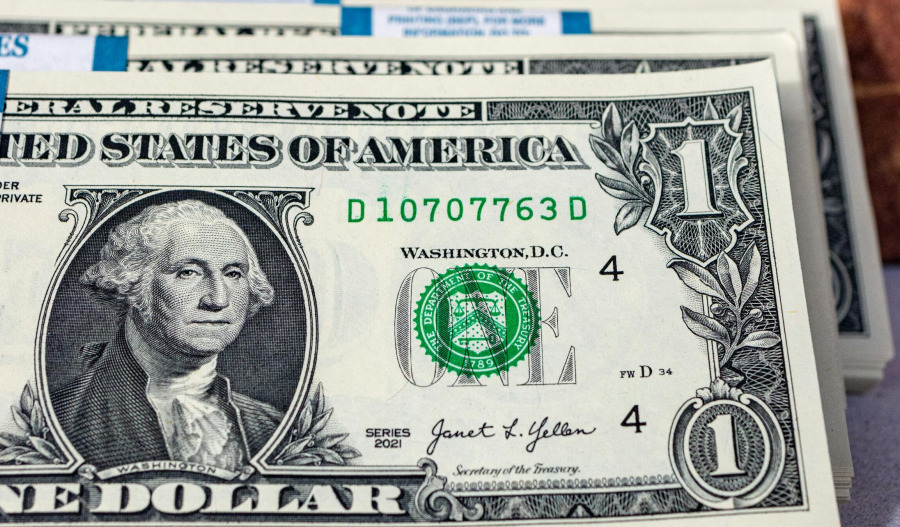The United States dollar index started the week near multi-month highs, despite weakening at the end of last week as renewed trade tensions between Washington and Beijing rattled markets and pushed investors towards safe-haven assets.
U.S. President Donald Trump’s threat of a “massive increase” in tariffs on Chinese imports triggered a sharp risk-off move across equities, bonds, and currencies, setting the tone for a volatile start to the week.
The DXY fell below 99.00, erasing part of its weekly gain as traders priced in the possibility that trade and political uncertainty could force the Federal Reserve into additional rate cuts before year-end.
Trump’s comments on Truth Social described Beijing’s rare earth export restrictions as “hostile” and accused China of using the minerals to hold the world “captive”. He also said he saw no reason to meet President Xi Jinping at the APEC summit in South Korea.
Beijing’s new rules require foreign companies to obtain special licences to export any product containing more than 0.1% of rare earth content, heightening fears of supply chain disruptions in sectors such as semiconductors, electric vehicles, and defence manufacturing.
The renewed confrontation between the world’s two largest economies triggered broad risk aversion.
U.S. Treasury yields fell, equities sold off sharply, and demand for safe-haven assets rose. According to the CME Group FedWatch Tool, markets now expect further Fed rate cuts in October and December if the trade dispute continues to dampen business confidence.
Euro rebounds as DXY weakens
The EUR/USD pair recovered to trade above 1.1600 on Friday, snapping a four-day losing streak as investors sold the Greenback amid trade jitters.
At the start of the new week, the pair was little changed around 1.1611.
French politics also grabbed attention after President Emmanuel Macron reappointed Sébastien Lecornu as Prime Minister, aiming to restore stability and ensure France’s 2026 budget passage.
“We must put an end to this political crisis that exasperates the French people,” Lecornu said.
However, lingering political uncertainty in France and weak Eurozone data continue to limit the Euro’s upside.
Aussie hit by trade tensions, RBA minutes ahead
The Australian Dollar (AUD) rebounded 0.5% early Monday, recovering from a 1.2% plunge on Friday when Trump’s tariff warning sparked a sell-off in risk-sensitive currencies.
Australia’s close economic ties with China made the Aussie particularly vulnerable to renewed trade tension headlines.
The Greenback’s retreat provided some relief, but sentiment remains fragile as traders await the Reserve Bank of Australia (RBA) meeting minutes on Tuesday and fresh employment data on Thursday.
Sterling flat amid fiscal concerns
The British Pound (GBP) began the week steady at 1.3348 after touching a two-month low on Friday as fiscal uncertainty weighed on sentiment.
Reports suggest UK Chancellor Rachel Reeves is considering new tax hikes in November’s Autumn Statement to tackle the widening budget deficit.
Meanwhile, Bank of England (BoE) policymaker Catherine Mann reiterated that monetary policy “must remain restrictive for longer” to fight inflation, noting, “Evidence from consumer behavior shows that we are not there yet.”
Lingering fiscal pressure and cautious central bank rhetoric continue to cap Sterling’s rebound potential.
Yen weakens as Japan’s political risk grows
The Japanese Yen (JPY) fell sharply last week, with USD/JPY trading above 152.40 as the Greenback gained amid political instability in Tokyo.
The pair started the week 0.6% higher, extending a rally of over 3.5% last week.
The sell-off followed the victory of Sanae Takaichi in the ruling LDP leadership race, sparking concerns that a return to Abenomics-style fiscal stimulus could delay the Bank of Japan’s (BoJ) policy tightening.
Further uncertainty arose as Komeito Party leader Tetsuo Saito threatened to leave the ruling coalition, citing “deep disagreements with the LDP on issues involving money and politics.”
Finance Minister Katsunobu Kato warned that authorities would “monitor for excessive market fluctuations and disorderly moves,” hinting at possible intervention if Yen weakness accelerates.
Economic Calendar Week Ahead
On Monday, trading volumes are expected to be light as Japan, and Canada remain closed for public holidays, while the United States bond markets will remain closed for a federal holiday.
In Asia, China will release its latest balance of trade figures, offering fresh insight into export performance amid ongoing trade tensions.
On Tuesday, a busy session will see several key releases across major economies. In the United Kingdom, investors will monitor the BRC retail sales monitor, average earnings, employment change, and the unemployment rate for signs of labour market strength.
Australia will publish the NAB business confidence index alongside the Reserve Bank’s meeting minutes, while in Europe, the ZEW economic sentiment index is due.
The United States will see the NFIB small business optimism index and Redbook retail data, while Federal Reserve Governor Michelle Bowman is scheduled to speak.
In Canada, building permits will provide an update on construction activity.
On Wednesday, attention will shift to a series of U.S. Federal Reserve speakers, including Chair Jerome Powell, Governor Christopher Waller, and Boston Fed President Susan Collins.
Data releases in the U.S. will feature the MBA 30-year mortgage rate and the New York State manufacturing index.
In Asia, China will publish inflation and producer price data, while Japan reports capacity utilisation and industrial activity.
The eurozone will release industrial production figures, and Canada will publish monthly manufacturing and wholesale sales numbers.
On Thursday, global markets will digest a wide range of data and central bank commentary. In the United States, traders will watch speeches from Fed officials Raphael Bostic, Adriana Kugler Miran, and Christopher Waller, alongside reports on weekly jobless claims, the producer price index, retail sales, and the Philadelphia Fed manufacturing index.
In Australia, Reserve Bank officials Michele Bullock and Christopher Kent are due to speak, coinciding with the release of employment and unemployment figures.
Japan will publish machinery orders and remarks from Bank of Japan board member Hajime Tamura.
Meanwhile, the UK will release GDP data, goods trade balance, and industrial and manufacturing production numbers.
Europe will also issue its balance of trade report, while in Canada, housing starts and the CFIB business barometer are on tap.
On Friday, the week concludes with a heavy flow of data from multiple regions. In the United States, the focus will be on business inventories, the NAHB housing market index, building permits, housing starts, industrial production, and the Fed’s balance sheet, alongside import and export price data.
Japan will release its import and export price indexes and the national unemployment rate, while the eurozone rounds out the week with final consumer price index figures, providing the latest reading on regional inflation trends.



